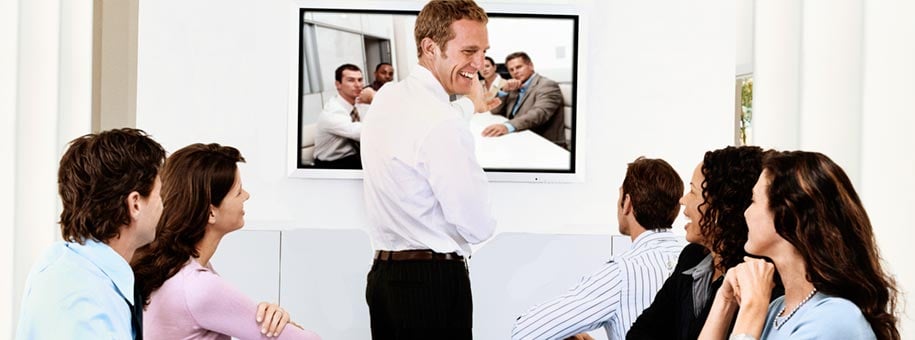
Welcome Back! This is part four of our series on How to Set Up a Video Conference Room Without Getting Fired.
As you plan for your video conference room, here are some tips and questions you should consider when choosing and deploying conference room video cameras:
- How does the camera connect? USB, HDMI, VGA? This makes a difference. In all cases you or your vendor should know the exact wire paths and distance between the content sharing locations, the video system (codec), any media rack, microphones, speakers and data drops. No all wiring can be extended without expensive converters or additional wiring costs. Be sure to get this right and have a guarantee in writing from your vendor. No change orders because they didn't measure or think this through!
- Does the camera have Pan - Tilt - Zoom, mechanical or digital or both? You will likely have come to a range of decisions on this based on the vendor, manufacturer and platform you have standardized on. Wait, what, standardize? Yes.... to the degree that you can stay consistent. This makes it easier for your end users, your support team and for the adoption of the overall solution. Know the limits of the cameras you have chosen and train the users accordingly.
- Field of view. Where you place it matters; glare, windows, wall coverings & color, etc. During a design phase you may have tested a camera or two. Are you aware of how for up, down, left or right the camera moves and how closely can it zoom in and zoom out? Do those functions fit the need? Assuming yes, then be sure you've placed the camera properly and designed to room so that it functions as desired and as designed by the manufacturer. Most dissatisfaction we see emerges when we see a mismatch between desire and design.
- Does the camera or it's software do any color correction? Much like the field of view, the software inside the camera technology can make a difference. The more you (or your vendor) know about the camera's digital abilities (not just the mechanical optics), the better choices you will make with modifying software to correct for environmental factors.
- Is there an ability to modify the camera settings? Not all cameras are created equally. At the low end, what you see (literally) is what you get. Need more from a camera related to software or field of view, then pay more. Ultimately you and your end users will be happier. If you opt to choose a camera designed for travel and the top of the laptop for your large board room, remind the users to expect what you have paid for and you should be set.
- Are you planning one, two, three (or more) cameras? How are they controlled? Is 3rd party control needed? When you design a room with multiple cameras in the room first remember that most video conferencing solutions assume you only want one camera on at a time. Next make sure the cameras are placed to fit the needs of a multi-functional room and users that may also function differently while being afraid of touching a control system you deploy.
- Tracking of voice switching? Just because it is cool, does mean you need it, right? Voice tracking cameras offer a great immersive experience, but a similar effect can be accomplished with preset camera zones. In the event you opt for a tracking camera, test it first with a group of users.
- Top of the line vs. budget brand? As implied by much of the above, you get what you pay for. This is worth calling out specifically because many of the common mistakes we clean up are vendors that suggest a less-expensive camera in order to win a deal and in order to stay on budget, rather than having the more challenging conversation about design, performance and expectations. Having the hopes for a low-end USB camera to function to the same ability as a high-end, codec integrated video conferencing system sets most deployments up for failure. Just as much as you get you pay for, may sure you pay for what you want to get.
- Who supports the camera, warranty, replacement and testing? Once in production, these systems should be set so you can forget. Be clear about warranty and support, because when a camera fails, it is really, really hard to have an immersive face to face video conference. OK, it's actually impossible, but what is possible is making sure this is documented and you are ready for a support event.
Thank for reading. Feel free to share this post with your friends or add comments or content we may have missed.
Tune in to part five of this blog series and learn a bit about the most common mistakes made when creating a room for video conference solution. Let Perfect Video Conferencing tie it all together for you. Sign up for a Free Demo today.
About Perfect Video Conferencing:
Founded in 2009 by Randy N. Marcotte and John Killcommons, Perfect Video Conferencing was born of a commitment to integrity and partnership and the desire to create a boutique brand based on white-glove service to its customers.
What started as a simple conversation about shared values evolved into Perfect Video Conferencing. Those seeds of dedication to innovation and customer satisfaction has moved PVC from a shining star in a clouded sky of VARs to our own constellation of VAP – Value-Added Partner.
As our industry evolves, we continue to innovate and forge relationships in order to provide our customers with the most up-to-date unified communications solutions backed by the most customer-focused support, remaining true to those inspirations that are at our foundation.

